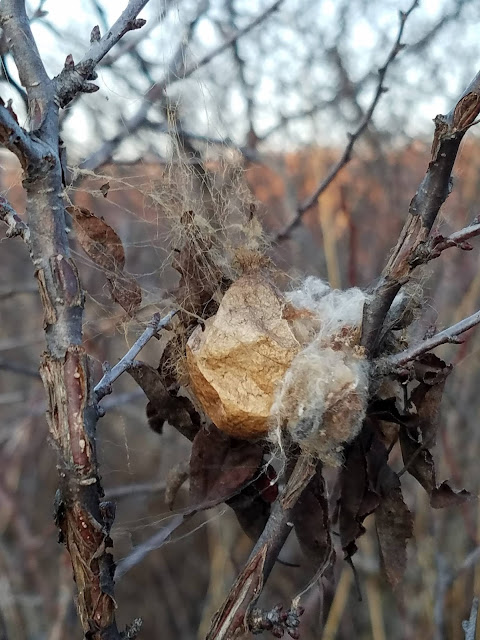Once the leaves have fallen, so many signs of life appear!
| ||
(All photos were taken at Bird Runner Wildlife Refuge in the Creek Field, an on-going restoration of bottomland tall grass prairie.)
Here is the egg sac of a Black-and-Yellow Garden Spider (Argiope aurantia), suspended from plum twigs.
The tiny spiderlings inside are waiting out the winter.
A neighboring Garden Spider was even more prolific. She produced two batches of A. aurantia:
A. Aurantia egg sacs, attached to plum twigs and leaves.
While some spiderlings grow strong inside their egg sacs, others turn into food for predators. Here is the egg sac of a Garden Spider ripped open by some hungry bird, possum, or raccoon (thank you, Betsy Betros, for explaining the scenario):
A preyed-upon Garden Spider egg sac attached to plums.
The oothecas of Chinese Mantises also appear in the plums:
The ootheca of a Chinese Mantis
(Tenodera sinesis) on a plum twig.
But woodpeckers love to snack on the eggs and nymphs of Chinese Mantises. Here is the tell-tale hole drilled by a woodpecker:
...while another Downy poses by her hoped-for lunch-bucket:
An occasional bagworm appears on the plums...
...along with the cocoon of a Tussock Moth (thanks to bugguide.net for the ID):
The cocoon is carefully wrapped in a plum leaf, just like a cigar, and firmly attached by silk to the end of a plum twig.
This rather tattered cocoon attached to a plum twig and leaf might have been made by a Polyphemus Moth, according to entomologist Dick Beeman (thank you, Dick! ):
But other signs of invertebrate life are harder to identify. I found the following in the plums and submitted photos to my expert friends, Kansas Arthropods, and bugguide, but so far no one has confirmed an ID. If viewers of this blog can help, your assistance would be welcome!
Among the mysteries were various combinations of silk and leaf attached to plum twigs:
And there was a strange, disk-shaped egg case, smaller than a dime and deposited on a plum twig, that sported three yellow eggs on the surface:
An egg sac on a plum twig with three yellow eggs on the surface.
Was this the product of one species or two?
For the moment, these invertebrate signs remain unidentified--perhaps to declare themselves at a later time.
Even when encased in ice, the plums are interacting with winter wildlife--both the kinds that are familiar to us and the kinds that are still mysterious.
Powerful life processes continue in the thickets of winter plums.
All photos by Margy Stewart
|
Saturday, January 11, 2020
Winter Plums, Winter Wildlife: Part 2 (Invertebrates)
Subscribe to:
Post Comments (Atom)
















No comments:
Post a Comment